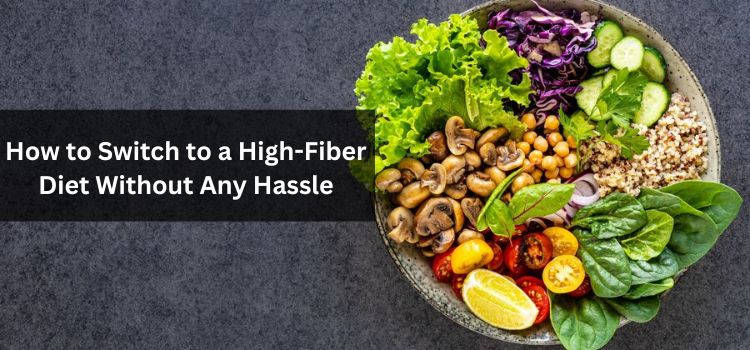In our fast-paced world, taking care of our health through a balanced diet is more important than ever. One specific dietary choice that’s been getting a lot of attention is switching to a high-fiber diet. Packed with fruits, veggies, whole grains, and legumes, this type of diet is known for its many health perks. Yet, making the shift to such a diet isn’t always a walk in the park. It comes with its own set of challenges, leaving many of us with the question, “How much time does it take for our bodies to get used to a high-fiber diet?”

Transitioning to a High-Fiber Diet
Transitioning to a high-fiber diet is a decision that should be made with careful thought. People often find themselves contemplating whether to make a gradual or sudden shift in their dietary habits. Some lean towards slowly introducing fiber-rich foods, while others prefer a more immediate change. Each approach has its advantages, but it’s important to note that common initial reactions can occur irrespective of the method chosen.
Digestive System Adaptation
The complex interaction between our digestive system and the trillions of gut bacteria is crucial in the way our bodies handle fiber. When we boost our fiber intake, the gut microbiota changes, adjusting to the new dietary elements. Grasping this process offers insights into the discomfort that some individuals may face during the initial phases of adopting a high-fiber diet.
Duration of Adaptation
Being patient is crucial when making the switch to a high-fiber diet. The body needs time to adapt to the higher fiber intake. Typically, this adjustment period spans from a few days to a few weeks on average. However, factors like age, overall health, and existing dietary habits can influence how long this transition takes for each individual.
Tips for a Smooth Transition
To make the adjustment process smoother, think about slowly introducing high-fiber foods into your meals. Begin by adding one new item at a time and make sure to stay well-hydrated to support your digestive function. These small adjustments can have a meaningful impact on how your body handles the increased fiber intake.
Managing Discomfort
Experiencing bloating, gas, or other digestive issues is not unusual when initially embracing a high-fiber diet. Although these symptoms typically diminish as the body adjusts, it’s crucial to address any lingering discomfort. Seeking advice from a healthcare professional can offer personalized guidance tailored to your specific situation..
Incorporating Variety in High-Fiber Diet
It’s essential to diversify your sources of fiber to maintain a well-rounded diet. Explore a variety of fruits, vegetables, whole grains, and legumes to ensure you’re getting a broad range of nutrients. Balancing your diet with different fiber-rich foods enhances the overall nutritional value of your meals.
Long-Term Benefits
The challenges that come with adjusting to a high-fiber diet are surpassed by the long-term benefits. Improved digestive health, reduced risk of chronic diseases, and better weight management are just a few of the positive changes individuals may notice. Embracing a high-fiber lifestyle establishes the groundwork for lasting well-being.
Monitoring Progress
It’s crucial to recognize signs of successful adaptation to a high-fiber diet. Increased energy levels, regular bowel movements, and an overall sense of well-being are indicators that your body is positively adjusting to the higher fiber intake. However, it’s important to stay attentive and be willing to make adjustments to your diet as needed.
Recipes and Meal Ideas
Enhance your high-fiber culinary experience with inventive recipes and meal ideas. From fiber-packed smoothies to hearty salads and wholesome soups, there are numerous delightful ways to infuse fiber into your daily meals. Experimenting with various ingredients ensures a flavorful and satisfying high-fiber diet.
Staying Motivated
Embarking on a dietary change can be challenging, but maintaining motivation is crucial for long-term success. Celebrate small victories, whether it’s trying a new high-fiber recipe or staying consistent with your dietary choices. Positive reinforcement is a powerful tool on the journey to a healthier lifestyle.
Common Myths about High-Fiber Diets
Clearing up misconceptions surrounding high-fiber diets is essential for making informed decisions. From concerns about nutrient absorption to misconceptions about taste, debunking these myths fosters a clearer understanding of the benefits associated with a fiber-rich lifestyle.
Expert Advice
Seeking guidance from nutritionists or healthcare professionals can provide invaluable insights tailored to your individual needs. These experts can offer personalized advice, taking into account your health history, lifestyle, and dietary preferences. Consulting with a professional ensures a well-informed approach to your high-fiber journey.
Success Stories
Meet Alex, a 40-year-old individual who decided it was time to prioritize their health and make a significant change in their diet. Alex had heard about the benefits of a high-fiber diet and was eager to experience the positive transformations firsthand. Little did they know that the journey would be both challenging and rewarding.
The Decision to Embrace Change
Motivated by a desire to improve digestive health and overall well-being, Alex made the conscious decision to transition to a high-fiber diet. Their typical diet had been lacking in fiber, filled with processed foods and minimal fruits and vegetables. It was time for a radical shift.
Week 1: The Beginning of the Challenge
In the first week, Alex started by incorporating small changes. Breakfast now included a bowl of oatmeal with berries, and lunch featured a colorful salad with a variety of vegetables. The initial days were marked by feelings of fullness and increased gas, prompting Alex to wonder if they had made the right choice.
With encouragement from online resources and a supportive community, Alex learned that these initial challenges were common during the body’s adjustment to a high-fiber diet. They decided to persevere, recognizing that change takes time.
Week 2: Adapting to the New Routine
As the days turned into the second week, Alex began to notice subtle shifts. Bowel movements became more regular, and the initial bloating started to subside. A newfound energy emerged, leading Alex to feel more active and engaged throughout the day.
To ensure a gradual adjustment, Alex continued to experiment with different high-fiber foods, introducing legumes and whole grains into their meals. The variety not only contributed to a well-rounded diet but also made the transition more enjoyable.
Week 3: Celebrating Small Victories
By the third week, Alex was experiencing the positive effects of the high-fiber lifestyle. Digestive discomfort had significantly diminished, replaced by a sense of lightness and improved overall well-being. The initial skepticism about the adjustment period transformed into excitement and motivation.
Celebrating small victories became a crucial part of Alex’s journey. Whether it was trying a new fiber-rich recipe or successfully resisting the temptation of processed snacks, each achievement fueled the commitment to the high-fiber diet.
Month 1: Sustained Changes and Feeling Empowered
As the first month concluded, Alex reflected on the remarkable changes. The body had successfully adapted to the high-fiber diet, and the initial challenges had become distant memories. The benefits were not only physical but also extended to mental clarity and a heightened sense of vitality.
Alex’s journey demonstrated that the body’s adjustment to a high-fiber diet is a dynamic process. Patience, perseverance, and a willingness to embrace change were key elements of this transformative experience. The initial discomfort gave way to a renewed sense of empowerment and a commitment to maintaining a high-fiber lifestyle for the long term.
Conclusion
In conclusion, the duration for the body to adjust to a high-fiber diet varies from person to person. Patience, gradual changes, and attention to individual needs are essential components of a successful transition. Embracing the positive changes in digestive health, overall well-being, and disease prevention makes the adjustment period well worth the effort.
FAQs
- How quickly can I expect to see changes in my body after adopting a high-fiber diet?
- Changes vary, but many individuals notice positive effects within a few weeks.
- Are there specific high-fiber foods recommended for a smoother transition?
- Foods like oatmeal, beans, and berries are often well-tolerated during the adjustment phase.
- Can I experience side effects while adapting to a high-fiber diet?
- Some individuals may experience temporary bloating or gas, but these symptoms typically subside.
- Is it necessary to consult a healthcare professional before starting a high-fiber diet?
- While it’s not mandatory, consulting with a professional can provide personalized guidance.
- Are cheat days allowed in a high-fiber diet?
- Occasional indulgences are acceptable, but maintaining overall consistency is key for lasting benefits.


